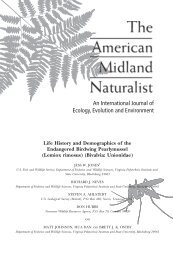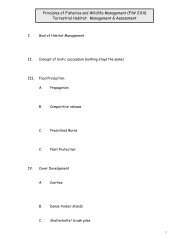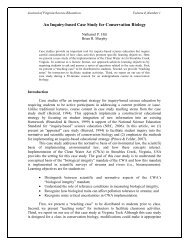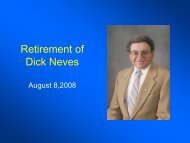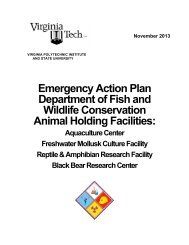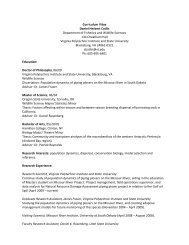Kernel Home Range Estimation for ArcGIS, using VBA - Fish and ...
Kernel Home Range Estimation for ArcGIS, using VBA - Fish and ...
Kernel Home Range Estimation for ArcGIS, using VBA - Fish and ...
You also want an ePaper? Increase the reach of your titles
YUMPU automatically turns print PDFs into web optimized ePapers that Google loves.
equal to or smaller than the distance typically traveled in the given sampling interval<br />
(displacement distance)(Figure 7.2.a.), then in theory, the animal would have left the area by the<br />
next sampling event (Figure 7.2.b.). Resightings in that area should only occur if the animal<br />
chose to stay in the area instead of moving its typical interval distance, or if it subsequently<br />
returned to the area (Figures 7.2.c-e). In both cases it is fair to assume that a high density of<br />
location estimates may reflect biological importance to the animal.<br />
a b c d e<br />
Figure 7.2. Appropriate choice of smoothing parameter based on the structure of the location<br />
data (sampling schedule) <strong>and</strong> the movement behavior of the species (displacement<br />
distance).<br />
ABODE provides a smoothing selection function in which the user can enter the sampling interval<br />
<strong>for</strong> the given dataset. This is the smoothing function “Displacement”. If ancillary data that include<br />
the day, month, <strong>and</strong> year of each location are provided, then ABODE will search the dataset <strong>and</strong><br />
find all consecutive location estimates <strong>for</strong> the given interval. The distance traveled between the<br />
locations will be calculated, <strong>and</strong> the arithmetic mean thereof will be used as the smoothing<br />
parameter <strong>for</strong> the dataset. In reality, not all studies will have the luxury of a generally consistent<br />
sampling interval. Many data are collected opportunistically, <strong>and</strong> will thus have an irregular<br />
sampling schedule. In such cases, ABODE can look <strong>for</strong> a sampling interval that best represents<br />
the data. The user should decide which measure of central tendency would best represent the<br />
data. ABODE can look <strong>for</strong> the median, mean <strong>and</strong> mode sampling interval. Be<strong>for</strong>e making a<br />
selection, the user should underst<strong>and</strong> the implications that outliers in the data will have on each<br />
estimate. It may be best to run all three analyses <strong>and</strong> choose a method that seems most<br />
appropriate.<br />
Sample size considerations dictate that ABODE uses a range of values <strong>for</strong> its search criteria.<br />
The mean sampling interval may not even be represented in the dataset, or may, at best, be<br />
represented by only a few actual data pairs. To base a travel distance on such a small sample<br />
size may produce undesirable results. Similarly, the median sampling interval may only be<br />
represented once in a dataset, <strong>and</strong> the mode, at least twice. ABODE will search <strong>for</strong> sampling<br />
intervals within a range that operates on an increasing scale (Table 1.). If the interval ABODE is<br />
searching <strong>for</strong> is less than 7 days, then the tolerance (on either side) is 0 days. If the interval is<br />
38



